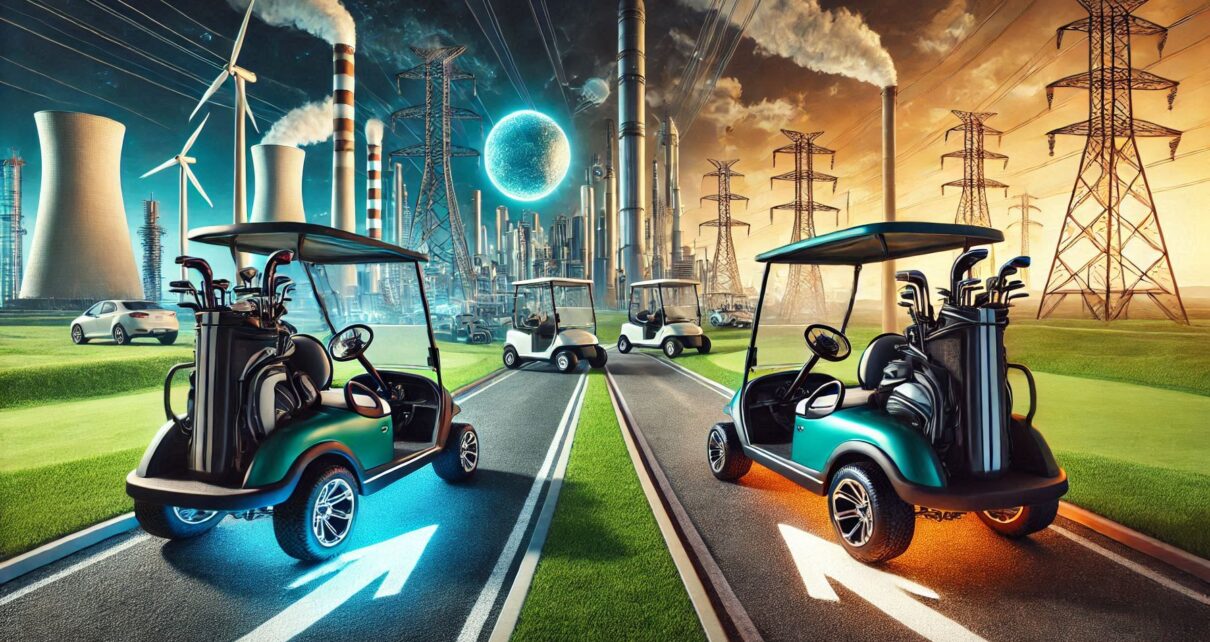Golf carts are no longer just for the golf course. Nowadays, they’re used in neighborhoods, resorts, farms, and even some urban areas. If you’re in the market for a golf cart, one big question you’ll face is whether to go with an electric golf cart or a gas-powered one.
Each type has its own set of advantages and drawbacks, and the right choice depends on your needs, lifestyle, and how you plan to use it. In this guide, we’ll take a deep dive into the world of electric and gas golf carts, breaking down their features, costs, and performance to help you decide which one is perfect for you.
Table of Contents
Understanding Golf Carts: The Basics
Before diving into the pros and cons, it’s important to understand what golf carts are and why they’re so versatile. Golf carts are compact vehicles designed to transport people and light cargo over short distances.
Golf carts come in various styles, sizes, and configurations, but they typically fall into two categories: electric-powered or gas-powered. Their uses extend beyond golf courses, and people rely on them for:
- Commuting within gated communities.
- Hauling equipment on farms or large properties.
- Transporting guests at events or resorts.
- Recreation and off-road adventures.
While they might seem simple, choosing the right cart can make a big difference in your day-to-day life.
How Electric Golf Carts Work
Electric golf carts run on rechargeable batteries, usually lead-acid or lithium-ion. These batteries power an electric motor, which drives the cart’s wheels. Here’s a quick breakdown of their key components:
- Battery Pack: Provides the energy needed to run the cart.
- Controller: Regulates the flow of electricity to the motor.
- Motor: Converts electrical energy into mechanical energy to move the cart.
You’ll charge the cart by plugging it into a power outlet or dedicated charging station. Fully charged, electric golf carts can typically travel 15–25 miles, depending on the model and terrain.
How Gas Golf Carts Work
Gas golf carts are powered by small internal combustion engines, similar to what you’d find in a lawnmower or small car. They run on regular unleaded gasoline, with key components including:
- Engine: Burns fuel to create mechanical energy.
- Fuel Tank: Stores gasoline, usually holding 5–6 gallons.
- Transmission: Transfers power from the engine to the wheels.
Gas golf carts are often equipped with a choke or starter to get the engine going. They’re capable of traveling longer distances and handling rough terrain with ease.
Key Differences Between Electric and Gas Golf Carts
To compare these two types, let’s look at some core differences:
| Feature | Electric Golf Cart | Gas Golf Cart |
| Power Source | Battery-powered | Gasoline-powered |
| Noise | Quiet | Loud engine noise |
| Fuel Cost | Low (electricity) | Higher (gasoline) |
| Maintenance | Minimal | Regular engine upkeep |
| Range | Shorter (15–25 miles) | Longer (100+ miles/tank) |
| Environmental | Eco-friendly | Emits pollutants |
| Terrain Handling | Moderate | Excellent |
Electric vs. Gas Golf Carts: Performance and Speed Comparison
When comparing electric and gas golf carts, performance and speed are two of the most significant factors to consider. While gas-powered carts have traditionally been known for their superior performance, electric models are catching up fast due to advancements in technology.
Gas Golf Carts: Performance and Speed
Gas golf carts have long been the go-to choice for those seeking power and performance. One of their key advantages is higher torque, which makes them ideal for heavy-duty tasks such as towing or navigating steep hills. The powerful engine enables these carts to handle tougher terrains with ease, making them more suitable for golf courses or properties with uneven landscapes.
In terms of speed, gas carts can reach up to 25 mph, making them faster than most electric models. This speed advantage is especially useful for long-distance trips or situations where quicker travel is necessary. Gas engines also allow for longer usage durations without the need to stop and recharge, as long as there is fuel available.
Electric Golf Carts: Performance and Speed
While gas carts have traditionally had the upper hand, electric golf carts have made significant strides in recent years. With advancements in battery technology, modern electric carts are now equipped with improved torque and speed boosters, allowing them to perform at higher levels than older models. Some of the latest electric carts can now achieve speeds of up to 20 mph, which is approaching the top end of gas-powered carts.
Electric carts have also benefited from a quieter, smoother operation, making them ideal for golf courses where noise can be a concern. Additionally, they require less maintenance, as there are fewer moving parts compared to gas engines. This can lead to lower long-term costs.
For everyday use on flat terrain, electric carts are often just as capable as their gas counterparts. They offer sufficient speed and power to navigate most golf courses, neighborhoods, or short-distance commutes with ease. And with the environmentally friendly aspect of electric motors, many people are choosing electric carts as a more sustainable option.
Key Differences to Consider:
- Torque: Gas carts excel at towing and climbing hills, making them the better choice for hilly or rugged terrain.
- Speed: Gas carts generally offer higher speeds (up to 25 mph), while electric carts can range from 12 to 20 mph, depending on the model.
- Maintenance: Gas engines require more maintenance due to fuel and engine components, while electric carts need less upkeep.
- Operating Costs: Electric carts can be cheaper to operate due to lower fuel costs and fewer maintenance needs.
Cost Analysis: Upfront and Long-Term
Upfront Costs
- Electric golf carts are generally more affordable upfront, with basic models starting at around $6,000–$8,000.
- Gas-powered carts cost more, averaging $8,000–$10,000 or higher.
- Premium models of either type can cost significantly more, depending on features and customization.
Operating Costs
- Electric Carts: Low-cost charging (~$0.10–$0.15 per charge).
- Gas Carts: Higher fuel expenses, depending on usage.
- Electric carts require minimal daily maintenance, reducing overall operating costs.
Long-Term Costs
- Electric carts may require costly battery replacements every 4–6 years, adding $1,000–$2,000 to the long-term cost.
- Gas carts incur ongoing maintenance costs for oil changes and engine repairs.
- Gas carts may need more frequent repairs as the engine ages, increasing maintenance costs.
Electric vs. Gas Golf Carts: Maintenance Requirements
Electric Golf Carts: Maintenance Requirements
- Water levels: Check and refill water levels in lead-acid batteries regularly. Low water levels can shorten battery life.
- Charging: Ensure the cart is regularly charged to keep it ready for use.
- Electrical connections: Inspect connections to prevent issues caused by loose or corroded parts.
- Minimal upkeep: Besides these tasks, electric carts require very little routine maintenance.
Gas Golf Carts: Maintenance Requirements
- Oil changes: Regular oil changes are essential to keep the engine functioning properly.
- Air filter replacements: These should be replaced periodically to maintain optimal engine performance.
- Fuel and spark plugs: Check fuel levels and spark plug performance for smooth engine operation.
- Engine tune-ups: Gas carts need occasional engine tune-ups to ensure peak performance and avoid costly repairs down the line.
Electric vs. Gas Golf Carts: Environmental Impact
Electric Golf Carts: Environmental Impact
- Zero emissions: Electric carts produce no emissions during use, making them an eco-friendly option.
- Renewable energy: They can be charged using renewable energy sources, like solar or wind power, further reducing their environmental impact.
- Low carbon footprint: As the electricity grid becomes greener, the overall carbon footprint of electric carts continues to decrease.
Gas Golf Carts: Environmental Impact
- Pollutant emissions: Gas-powered carts emit pollutants, contributing to air pollution and a higher carbon footprint.
- Larger carbon footprint: The combustion of fuel increases the environmental toll of gas carts.
- Off-road necessity: Gas carts remain essential in rugged, off-road conditions where electric models may not perform as well.
Range and Battery Life vs. Gas Tank Capacity
Electric Golf Carts: Range and Battery Life
- Limited range: Electric carts typically offer a range of 15–25 miles per charge, making them perfect for short trips or casual use.
- Charging needs: Frequent charging is required for longer trips, but they are ideal for use on golf courses or residential areas.
- Battery life: Battery life can last for several years but may degrade over time, affecting the range.
Gas Golf Carts: Gas Tank Capacity
- Extended range: With a full tank, gas-powered carts can travel over 100 miles, making them suitable for long-distance trips.
- Ideal for remote areas: Gas carts are ideal for use in rural areas, off-road environments, or places without easy access to charging stations.
- Fuel refills: Unlike electric carts, gas carts can quickly refuel, making them more convenient for longer durations.
Electric vs. Gas Golf Carts: Noise Levels and Comfort
Electric Golf Carts: Noise Levels and Comfort
- Almost silent operation: Electric carts operate with very little noise, providing a peaceful ride.
- Ideal for quiet areas: Their quiet nature makes them perfect for neighborhoods and golf courses, where noise can be disruptive.
- Smooth ride: The lack of engine noise often leads to a more relaxed driving experience.
Gas Golf Carts: Noise Levels and Comfort
- Engine noise: Gas-powered carts produce noticeable engine noise, which can be disruptive in quiet areas.
- Less peaceful ride: The noise can detract from the overall comfort, especially in calm environments.
- Louder operation: The engine’s sound can make the ride feel less smooth and more mechanical.
Electric vs. Gas Golf Carts: Durability and Terrain Suitability
Electric Golf Carts: Durability and Terrain Suitability
Electric golf carts are well-suited for smooth surfaces and light-duty tasks. They perform well on flat terrains, such as golf courses or residential areas, providing a durable and reliable ride for everyday use. However, electric carts are not ideal for rugged terrain or steep hills, as their power output is generally lower than that of gas-powered carts. They may struggle under heavy loads or in off-road conditions, limiting their performance in more demanding environments.
Gas Golf Carts: Durability and Terrain Suitability
Gas-powered golf carts are built for more rugged conditions, such as steep hills, rough terrain, and heavy-duty tasks. Their powerful engines allow them to handle tough off-road conditions, making them the preferred choice for navigating uneven landscapes or towing heavy loads. Gas carts are more durable when it comes to handling rough terrain and can maintain high performance even in challenging environments, making them ideal for both outdoor adventures and long-lasting reliability.
Electric vs. Gas Golf Carts: Customization and Upgrades
Electric Golf Carts: Customization and Upgrades
- Lift kits: Electric carts can be upgraded with lift kits for improved ground clearance, making them more suitable for slightly rougher terrains.
- Seating and storage: You can enhance electric carts with upgraded seating options or added storage to improve comfort and convenience.
- Accessories: Common accessories like windshields, lights, and stereos can be easily added to electric carts to enhance the overall experience.
- Motor upgrades: Electric carts tend to have limitations when it comes to motor upgrades. The electric motor’s capacity may restrict the types of performance modifications you can make.
Gas Golf Carts: Customization and Upgrades
- Lift kits: Just like electric models, gas carts can also be equipped with lift kits for better ground clearance, especially useful for off-road environments.
- Seating and storage: Gas-powered carts offer plenty of opportunities for customized seating and extra storage, making them more versatile for carrying gear.
- Accessories: Windshields, lights, and stereos are easy to install, and gas carts can even support more advanced audio systems or custom styling.
- Engine performance: Gas carts are more modifiable in terms of engine upgrades, allowing for improvements in speed, torque, and overall performance. With engine modifications, they can be tailored for greater power and efficiency.
Best Uses for Electric Golf Carts
- Quiet neighborhoods: Electric carts are ideal for peaceful residential areas due to their silent operation, making them non-disruptive.
- Eco-conscious buyers: For those prioritizing sustainability, electric carts are the preferred choice, producing zero emissions and being environmentally friendly.
- Light commuting or recreational activities: Perfect for short-distance trips, such as neighborhood commutes or recreational outings, electric carts offer a smooth and efficient ride on flat terrain.
Best Uses for Gas Golf Carts
- Farms or large properties: Gas carts are ideal for navigating vast areas like farms or large properties where electric carts might struggle with range or power.
- Off-road adventures: With their powerful engines, gas carts excel in rough terrain and are perfect for off-road exploration.
- Extended travel distances: Gas-powered carts are the go-to choice for long-distance trips, offering a greater range and faster refueling times than electric models.
FAQs About Electric and Gas Golf Carts
How long does it take to charge an electric golf cart?
Charging an electric golf cart typically takes between 4 to 8 hours, depending on the battery size and charger used. If you’re using a standard charger, it may take the full 8 hours for a complete charge. Some modern chargers offer fast-charging options, which can reduce charging time to about 2 to 4 hours, but this depends on the cart’s battery capacity and the charger’s specifications. For optimal performance and battery life, it’s best to charge the cart overnight or after every use, ensuring it’s always ready for the next ride without draining the battery completely.
Can I use an electric golf cart in the rain?
Yes, you can use an electric golf cart in the rain, but it’s important to take precautions. Most carts are designed to handle light rain, but avoid driving through heavy downpours or deep water. Ensure the cart’s electrical components are properly sealed, and always dry it thoroughly after use.
How often should I service a gas golf cart?
A gas golf cart should be serviced regularly to maintain optimal performance. It’s recommended to perform a basic maintenance check every 100-200 hours of use, or roughly every 6-12 months. This includes oil changes, air filter replacements, and spark plug checks. Additionally, it’s important to inspect the fuel system, brakes, and tires. If you use the cart heavily or in challenging conditions, more frequent maintenance may be necessary to ensure the engine runs smoothly and efficiently.
Can gas carts be converted to electric?
Yes, gas golf carts can be converted to electric, but it requires a significant amount of work and investment. The conversion process involves replacing the gas engine with an electric motor, installing a battery pack, and modifying the wiring and electrical systems. You’ll also need to install a suitable charger and make adjustments to the cart’s frame or components to accommodate the new setup. While the conversion is possible, it’s often complex and can be costly, requiring specialized knowledge or professional help. If done correctly, however, it can give you the benefits of an electric golf cart without purchasing a new one.
Are electric carts cheaper to operate?
Yes, electric golf carts are generally cheaper to operate than gas carts. They have lower charging costs, typically around $0.10–$0.15 per charge. Electric carts also require less maintenance, as they don’t need regular oil changes or fuel. Over time, this can result in significant savings.
Which type lasts longer?
In terms of lifespan, electric golf carts typically last longer in terms of overall usage. With proper maintenance, an electric cart’s battery can last 4 to 6 years, and the cart itself can last 10–15 years or more. Electric carts have fewer moving parts and require less maintenance, which helps extend their lifespan.
Gas golf carts, on the other hand, have longer operational life when considering engine performance, but they require more frequent maintenance, including oil changes, fuel system checks, and engine repairs. The engine can last up to 15 years, but regular maintenance is essential for longevity.
Conclusion: Which One is Right for You?
Choosing between an electric and gas golf cart boils down to your specific needs. If you prioritize quiet operation, eco-friendliness, and low maintenance, an electric cart is the way to go. On the other hand, if you need power, range, and off-road capabilities, a gas cart will better serve you.
Take the time to evaluate your priorities, budget, and intended use to make the best decision. Both options have their strengths, and the right one can elevate your golf cart experience.




